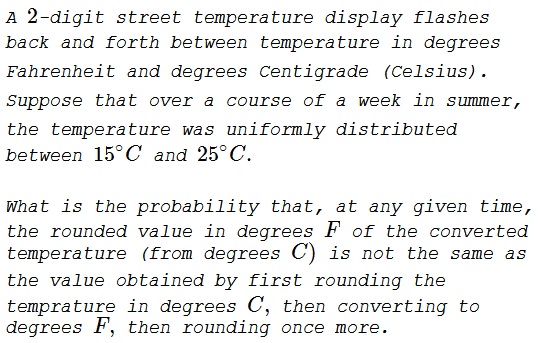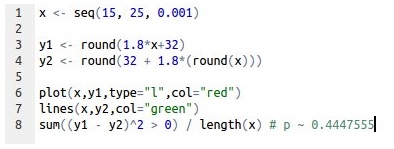Converting Temperature From $C^{\circ}$ to $F^{\circ}$
Problem

Solution 2
The conversion from $C$ to $F$ is given by
$\displaystyle F=\frac{9}{5}C+32.$
The $32$ is just an integral constant, the rounding steps do not affect it, and can be dropped in the context of the problem. Also, the problem is periodic in $C$ with a period of $5$. So WLOG, we can map all the $C$ values modulo $5$ to a range $[0,5]$. In fact, the range $[2.5,5.0]$ can also be mapped to $[0,2.5]$ by using a map $f(x)=5.0-x$ without changing the considerations of the problem. This can be seen from the following argument. Consider two intervals $p\in [0,2.5)$ and $q\in (2.5,5]$ for $C$ (modulo $5$) (The second and third columns in the table below). The notation $R(\cdot)$ is for rounding. Whenever, $p$ is different from $R(p)$ or $9p/5$ is different from $R(9p/5)$, $q$ is symmetrically different from $R(q)$ and $9q/5$ from $R(9q/5)$.
$\begin{array}{ l | c |c | r } \hline C && 5K+p & 5K+q \\ && & (=5K+5-p) \\ \hline\\ \hline R(C) && 5K+R(p) & 5K+5-R(p) \\ \hline 9C/5 && 9K+9p/5 & 9K+9q/5 \\ && & (=9K+9-9p/5) \\ \hline R(9C/5) && R(9p/5) & 9-R(9p/5) \\ \hline \end{array}$
Thus, WLOG, let us assume $0\leq C\leq 2.5$ and $F=\frac{9}{5}C$. Hence, with or without any of the rounding steps, the converted $F$ will lie in $[0,4.5]$. The notation $R(\cdot)$ is used for rounding. The different intervals are tabulated below:
$ \begin{array}{ l | c | c | c| r } \hline C & R(C) & 9C/5 & 9~R(C)/5 & 9C/5 \text{ intervals with} \\ & & & & \text{differences in rounded values} \\ \hline 0-0.5 & 0 & 0-0.9 & 0 & 0.5-0.9 \\ 0.5-1.0 & 1 & 0.9-1.8 & 1.8 & 0.9-1.5 \\ 1.0-1.5 & 1 & 1.8-2.7 & 1.8 & 2.5-2.7 \\ 1.5-2.0 & 2 & 2.7-3.6 & 3.6 & 2.7-3.5 \\ 2.0-2.5 & 2 & 3.6-4.5 & 3.6 & N/A \\ \hline \end{array}$
Thus, the required probability is
$\displaystyle \frac{(0.9-0.5)+(1.5-0.9)+(2.7-2.5)+(3.5-2.7)}{4.5} =\frac{2}{4.5}=\frac{4}{9}$
Illustration
The graph below lets one visually compare to kinds of conversion:

The graphs were produced by this small piece of code:

Different ranges
Acknowledgment
The problem is #108 from A Mathematical Orchard by M. I. Krusemeyer, G. T. Gilbert, L. C. Larson (MAA, 2012).
Solution 2 is by Amit Itagi. Keith Dawid has kindly supplies the table of probabilities for a vareity of ranges. The illutsration is by Attila Kun.
Generating Functions
- Generating Functions
- A Property of the Powers of 2
- An USAMTS problem with light switches
- Examples with series of figurate numbers
- Euler's derivation of the binary representation
- Examples with finite sums with binomial coefficients
- Fast Power Indices and Coin Change
- Number of elements of various dimensions in a tesseract
- Straight Tromino on a Chessboard
- Ways To Count
- Probability Generating Functions
- Finite Sums of Terms 2^(n-i) i^2
- Sylvester's Problem, a Second Look
- Generating Functions from Recurrences
- Binet's Formula via Generating Functions
- Number of Trials to First Success
- Another Binomial Identity with Proofs
- Matching Socks in Dark Room
|Contact| |Front page| |Contents| |Probability|
Copyright © 1996-2018 Alexander Bogomolny73581430
